List of Dinosaurs... By U.S. State!
State symbols have been around since 1893, when the World Fair in Chicago featured a National Garland of Flowers with a flower for each of the fifty states. While these flowers didn’t necessarily become state symbols, the idea was born. Soon, every state had adopted its own state symbols— typically a tree, flower, and bird.
State symbols celebrate and encapsulate what makes a state special and unique, and can be anything from wildlife to food to scientific discoveries.
There’s no official process for adopting a state symbol, but it usually happens when a group of citizens approaches their state government with a request to recognize something important to their state and elevate its status.
So it’s no surprise then, that several states where dinosaur bones have been discovered have honored the occurrence by naming the dino a state symbol. 10 states, plus the District of Columbia, have an official state dinosaur, while six more states have an official state fossil that happens to be a dinosaur, too.
We're going to dig our way through 17 states and discover their state dinosaurs. There’s plenty of info to get your minds raptor-round so let’s get going.
Arizona State Dinosaur: Sonorasaurus
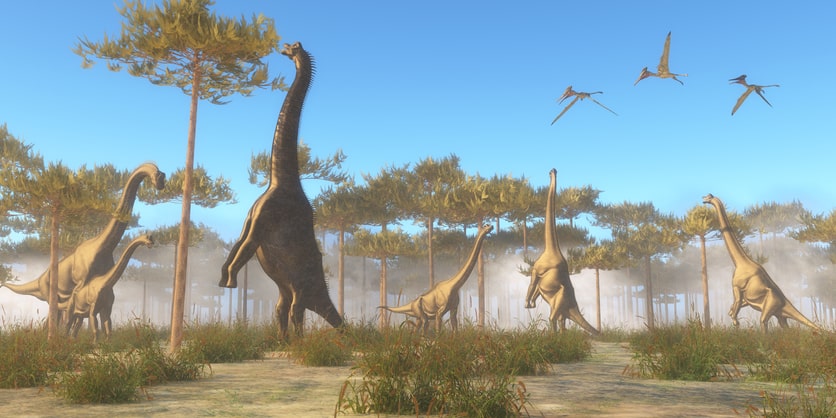
Scientific Name: Sonorasaurus thompsoni
Period: Early to Late Cretaceous period
First Discovered: 1994
The only Sonorasaurus fossils were discovered in 1994 by a geology student named Richard Thompson (who lent his surname to the dinosaur). He found them in a rock wall in the Sonora Desert, and informed the paleontologist at the Arizona-Sonora Desert Museum, Ronald Ratkovich, of the find. Ratkovich excavated the fossil over a period of four years, and it was he who named this dinosaur.
Sonorasaurus stood 15m long and 8m tall. Impressive as this is, it was only about one-third as massive as its famous relative, the Brachiosaurus.
Following a letter from 11-year-old budding paleontologist Jax Weldon, the Arizona Governor made Sonoroasaurus the state dinosaur in 2018.
Arkansas State Dinosaur: Arkansaurus
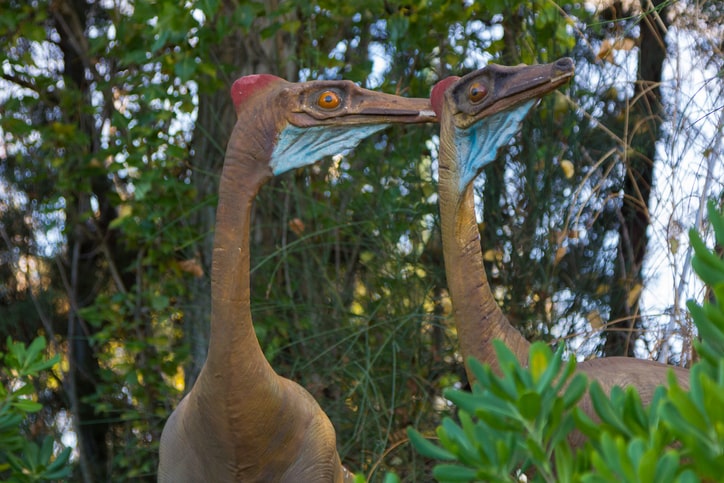
Scientific Name: Arkansaurus fridayi
Period: Early Cretaceous
First Discovered: 1972
After being buried in the earth for millions of years, the fossil bones of this dinosaur spent their first few months above ground in the unlikely setting of a service station. When circling vultures prompted station owner Joe Friday to check on his livestock, he discovered the bones in a ditch. He then displayed them in his station for several months.
That was until they were spotted by a passing paleontologist from the University of Arkansas, where they now reside.
It is the only dino fossil to be discovered in Arkansas to date and it was made a state symbol in 2017. One major reason for this was to obtain a pleasing numerical symmetry— Arkansas was the 25th state admitted to the union, but it had 24 state symbols. Adding Arkansaurus to the list matched the numbers nicely.
Arkansaurus was an ornithomimosaur, meaning ‘bird-mimic lizard’. These dinos were believed to have had a slight resemblance to an ostrich.
California State Dinosaur: Augustynolophus

Scientific Name: Augustynophylus morrisi
Time Period: Late Cretaceous
First Discovered: 1939
Hadrosauridae (duck-billed dinosaurs) were known to roam the West Coast in prehistoric times. One such dino was the Augustynophylus. Many hadrosaur fossils have been found in California, but paleontologists are unable to determine which species they belong to. However, they have identified the only two known specimens of Augustynophylus.
Since both were found in California, it was the obvious choice for a dino state symbol and it became one in 2017.
The first specimen was discovered in 1939, and the second one a few years later. The latter was more complete and larger than the first, suggesting the original may have been a juvenile. It’s one of the last known fossils before the mass extinctions believed to be caused by a meteor strike around 66 million years ago.
Augustynophylus was around 8m long and was named for the Augustyn family, who had supported the Natural History Museum of Los Angeles (where the fossils reside), and the paleontologist William Morris.
Colorado State Dinosaur: Stegosaurus
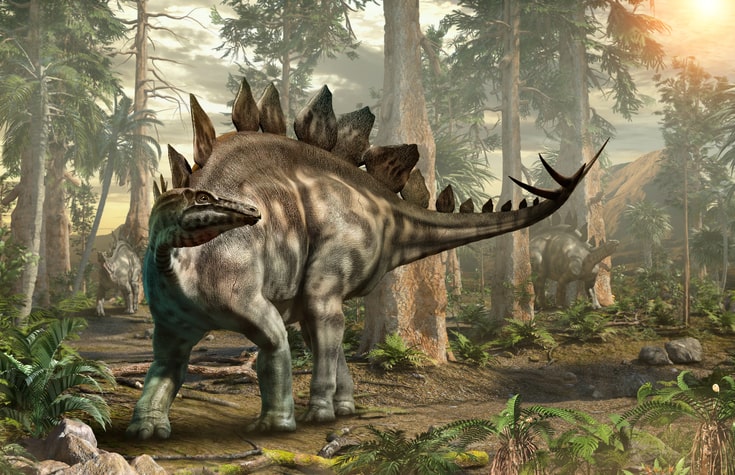
Scientific Name: Stegosaurus armatus
Period: Late Jurassic
First Discovered: 1876
One of the few state dinosaurs that are household names, the first Stegosaurus fossil was discovered in Colorado. It was first described by paleontologist Othniel Charles Marsh during the infamous "Bone Wars", a fierce rivalry between Marsh and his fellow paleontologist, Edward Drinker Cope (we’ll hear more from those two throughout this article).
Stegosaurus means ‘roofed lizard’. The name was given because it was initially thought that its distinctive backplates were part of a shell, similar to a tortoise’s. The purpose of the backplates is the subject of speculation, with paleontologists differing on whether they were used for defense, display, or even temperature regulation.
Stegosaurus was the first dinosaur to become a state symbol. It reached this status in 1982 following a campaign from a fourth-grade class.
Connecticut State Dinosaur: Dilophosaurus

Scientific Name: Dilophosaurus wetherili
Period: Early Jurassic
First Discovered: 1940
This dino actually made a strong case for becoming the state dinosaur of Arizona. In 1940, a member of the Navajo discovered three Dilophosaurus fossils in northern Arizona. When an expedition from the University of California came to the area hunting for fossils, he showed them the trio he’d discovered two years before.
Subsequent discoveries of more fossils revealed that Dilophosaurus possessed a pair of crests on its head, hence its name which means ‘two-crested lizard’.
Connecticut adopted it as the state dinosaur in 2017, after dinosaur tracks discovered in 1960 were found to belong to Dilophosaurus. They’re now on display in Dinosaur National Park.
Delaware State Dinosaur:
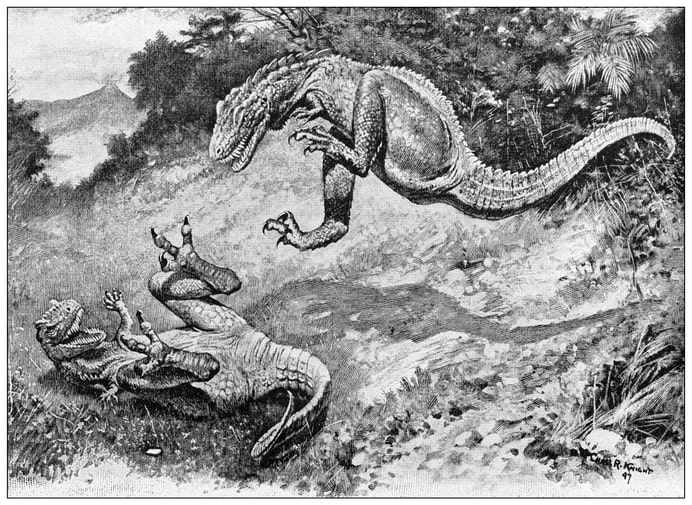
Scientific Name: Dryptosaurus aquilunguis
Period: Late Cretaceous
First Discovered: 1886
One of the most recently appointed state dinosaurs is also one of the most fearsome. Dryptosaurus became Delaware’s state dino in 2022 after middle school students drafted a bill that the state government passed.
It’s a member of the Tyrannosauroid family, though at 7.5 meters long Dryptosaur was smaller than its famous cousin the T-Rex.
Its discoverer is unknown but it was first described in 1866 by Edward Drinker Cope.
District of Columbia State Dinosaur: Capitalsaurus

Scientific Name: N/A
Period: Early Cretaceous
First Discovered: 1898
The real identity of this dinosaur is an eternal mystery. When a single vertebra was discovered in during the construction of a sewer in 1898, paleontologists didn’t have enough evidence to formally identify the species. All they knew was that it belonged to a large theropod— dinos with hollow bones and three toes that are the ancestors of birds. It may have been similar to the Dryptosaurus.
Since it was never identified, it was given the somewhat unimaginative name of Capitalsaurus. Many myths surround the dino, but the fact is there simply isn’t enough fossil evidence to derive any truth.
Either way, it’s still a widely recognized feature of Capitol Hill. The site of its discovery is named Capitalsaurus Court and it became the official dinosaur in 1998, the centenary of its discovery.
Massachusetts State Dinosaur: Podokesaurus
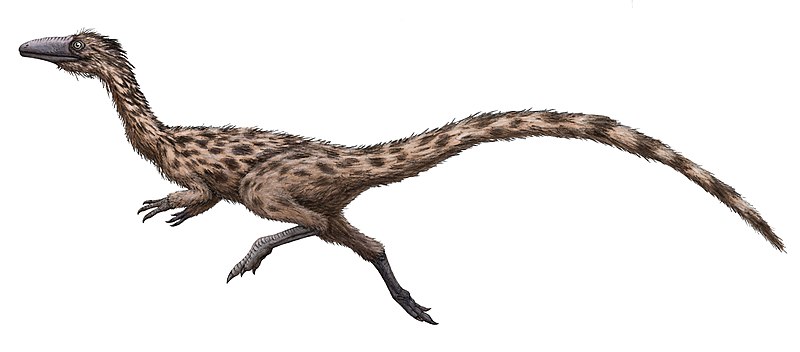
Scientific Name: Podokesaurus holyokensis
Period: Mid-Jurassic
First Discovered: 1910
Another newbie on the state dinosaur scene, Podokesaurus is one of the few to have been discovered by a woman.
The American geologist Mignon Talbot discovered the exposed fossil in 1910 while walking with her sister near Mount Holyoke, Massachusetts. It’s the only known example of the species.
Podokesaurus was around 1 meter long and its name means ‘swift-footed lizard’.
It was made the state dino of Massachusetts in 2022 to promote the love of science and recognize its importance.
Maryland State Dinosaur: Astrodon
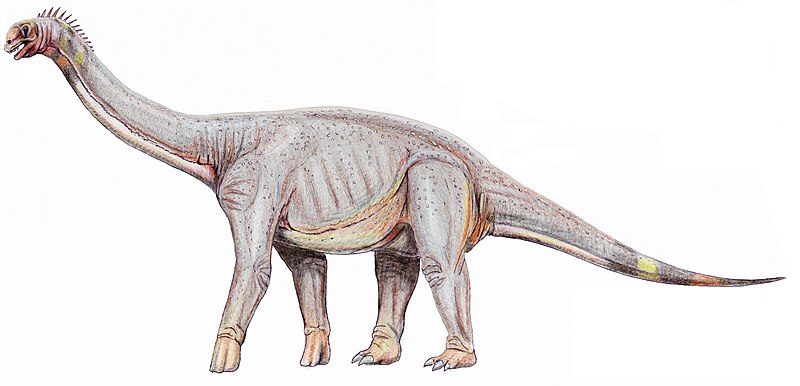
Scientific Name: Astrodon Johnstoni
Period: Early Cretaceous
First Discovered: 1858
Astrodon was one of the first dinosaurs to be discovered on US soil when two of its teeth were found in an iron pit in the Arundel Formation near Swampoodle, Maryland, in 1858.
Following their discovery, they were taken to Cristopher Johnson, a professor of dentistry. He cut a tooth in half and found the characteristic star-shaped cross-section— this provided the inspiration for the name. He didn’t assign his own name to the dino— this was done later by a paleontologist following the discovery of more bones.
Like the Sonorasaurus, Astrodon was a sauropod. These huge dinos were typified by their four short, stocky legs and incredibly long necks and tails. Astrodon was around 20 meters long and 9 meters tall.
It became Maryland's state dinosaur in 1998.
Missouri State Dinosaur: Hypsibema Missouriensis

Scientific Name: Hypsibema missouriensis
Period: Late Cretaceous
First Discovered: 1942
This obscure dino was initially believed to be a sauropod but is actually another example of a Hadrosaurid (duck-billed dinosaur). It was discovered by members of the Chronister family while digging a cistern on their land in Bollinger County. The area is now known as the Chronister Dinosaur Site.
The dino is the only specimen found in Missouri and it was made a state dinosaur in 2004. Following this, the local government in Bollinger County made Hypsibema missouriensis the face of their tourism campaign.
There has been some debate over the naming of the dinosaur, with some paleontologists arguing it should be named Parrosaurus missouriensis.
New Jersey State Dinosaur: Hadrosaurus
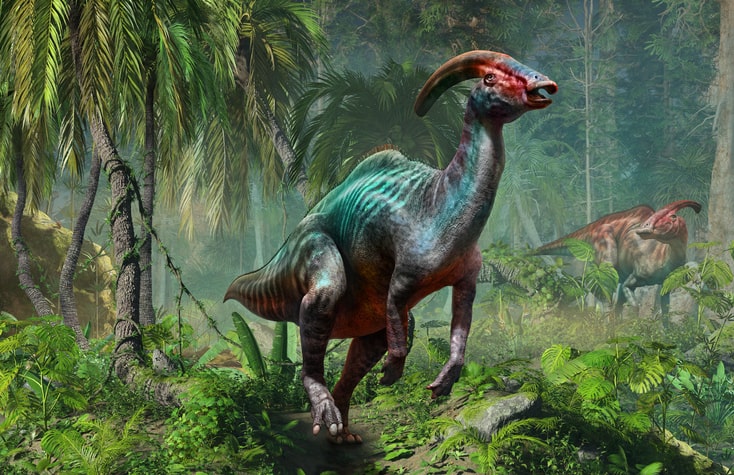
Scientific Name: Hadrosaurus foulkii
Period: Early Cretaceous
First Discovered: 1858
This dino is one of the most nationally significant on the list. The first bones were discovered in 1838 and displayed in the finder’s home in Haddonfield, New Jersey. However, it wasn’t until 1858 that they were identified as dinosaur fossils by William Parker Foulke. That made it the first dinosaur to be discovered in North America.
And that wasn’t the only ‘first’ this groundbreaking dino achieved. Ten years later, it became the first dinosaur skeleton to be mounted. It was displayed at the Philadelphia Academy of Natural Sciences.
It was made New Jersey’s state dino in 1991 thanks to efforts by a fourth-grade class to officially celebrate the dinosaur.
Oklahoma State Dinosaur: Acrocanthosaurus
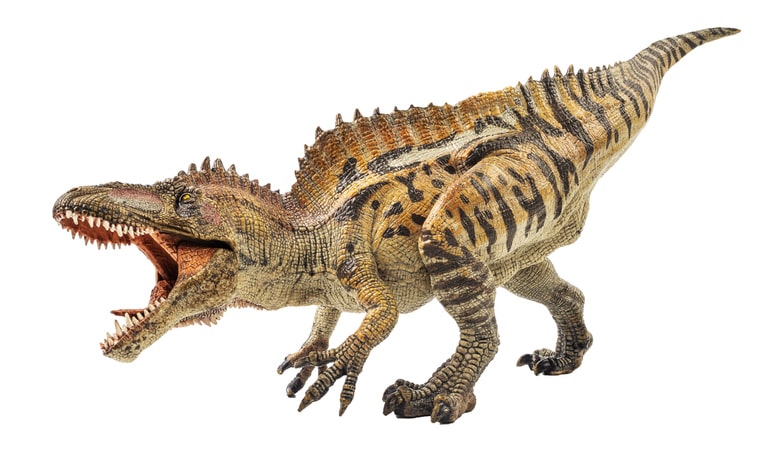
Scientific Name: Acrocanthosaurus atokensis
Period: Early Cretaceous
First Discovered: 1940
If you had to bet on which dinosaur might win in a fight between all the beasts on this list, Arocanthosaurus wouldn’t be a bad choice. It belonged to a group of huge theropod dinosaurs known as carcharodontosaurids (shark-toothed lizards). These were among the largest land-based predators to have ever lived.
Acrocanthosaurus resembled a t-rex but with a protruding spine (its name means ‘high-spined lizard’).
Fossil remains have been found in Texas, Utah, Wyoming, and even Maryland. It’s believed to have roamed the entire continent. However, the first specimen was found in 1940 in Atoka County, Oklahoma.
It became the state dinosaur of Oklahoma in 2006.
Oklahoma State Dinosaur: Saurophaganax
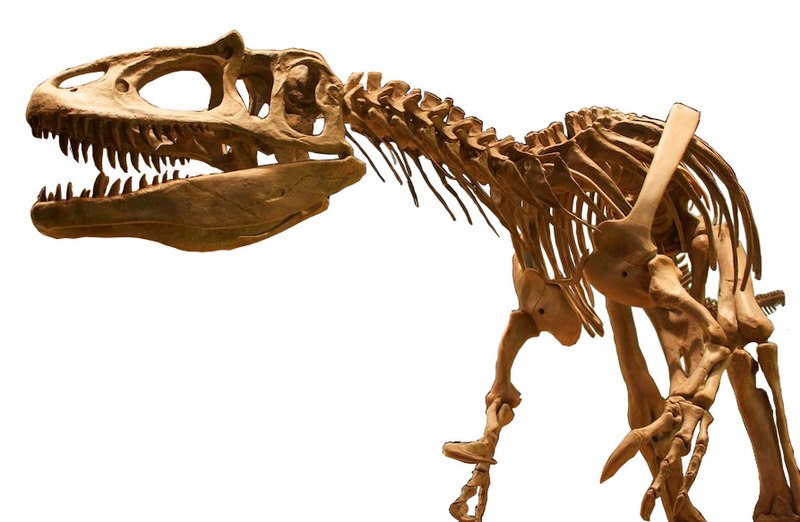
Scientific Name: Saurophaganax maximus
Period: Late Jurassic
First Discovered: 1931
Oklahoma claims another spot on the list as its state fossil is also a dinosaur. And it too is a huge bipedal carnivore that roamed North America. It would never have crossed paths with Acrocanthosaurus, however, as it lived millions of years earlier.
It was discovered by John Willis Stovall, a paleontologist at the University of Oklahoma, in Cimmaron County. Its name means ‘lord of the lizard eaters’, and would certainly have given Acrocanthasaurus a run for its money.
Texas State Dinosaur: Sauropoiseidon
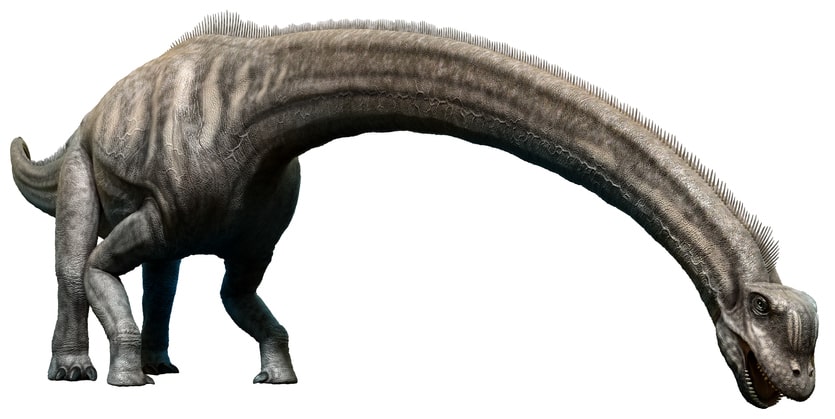
Scientific Name: Sauropoiseidon proteles
Period: Early Cretaceous
First Discovered: 1994 (although they weren’t identified as dinosaur bones until 1999)
A dinosaur so colossal, that when its bones were discovered, they were believed to be pieces of a petrified tree trunk. Surely no animal could have such big bones?
Well, it turns out they could, and they belonged to possibly the tallest dinosaur that ever walked the earth, able to raise its head as far as 18 meters. It’s not the longest or most massive dino, as is sometimes incorrectly claimed.
The first Sauropoiseidon fossils, four neck vertebrae, were discovered in Oklahoma near the Texas border. It wasn’t until five years later, when a graduate paleontologist reanalyzed them, that they were identified as dino bones. It cooked up quite a media frenzy.
A fossil site containing sauropod bones had been discovered in Texas in the 1980s, and the specimen was later given the name Paluxysaurus jonesi. However, later analysis led scientists to the conclusion that this and Sauropoiseidon were in fact the same animal.
Sauropoiseiodon became Texas’s state dino in 2009, joining other Texan animals. It replaced Pleurocoelus, another sauropod that was originally believed to have been responsible for trackways found at the Glen Rose dinosaur site. When it became clear that they were actually Sauropoiseidon tracks, Pleurocoelus had to step aside.
It’s fitting that the largest state on the list should get the largest state dinosaur. Its footsteps would no doubt have shaken the very ground. Indeed its name means ‘lizard earthquake god’ and comes from the Greek god Poseidon, who was the god of the seas, storms, and earthquakes.
Utah State Dinosaur: Utahraptor
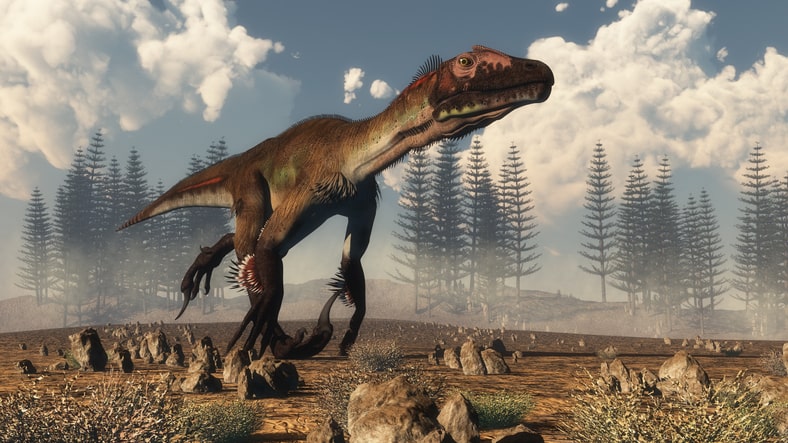
Scientific Name: Utahraptor ostrommaysi
Time Period: Early Cretaceous
First Discovered: 1975
Utah is one of the most prolific states when it comes to dinosaur fossils, and it’s certainly chosen some blockbuster dinos for its state symbols.
Utahraptor was a feathered raptor around 7 meters long, with ferocious curved claws on its hind legs that could tear apart its prey. Its more famous cousin, the Velociraptor, was much smaller. In fact, the velociraptors portrayed in Steven Spielberg’s 1993 classic, "Jurassic Park", were much more resemblant to Utahraptors.
They were first discovered in 1975, although the discoveries of more bones in 1991 and 2001 were more significant.
It was made the state dinosaur in 2018. Initially, it was to replace Allosaurus as the state fossil. However, Utah legislators perhaps thought that one lean mean killing machine wasn’t enough, so they kept Allosaurus as the state fossil and created the position of state dinosaur for Utahraptor.
Utah State Dinosaur: Allosaurus
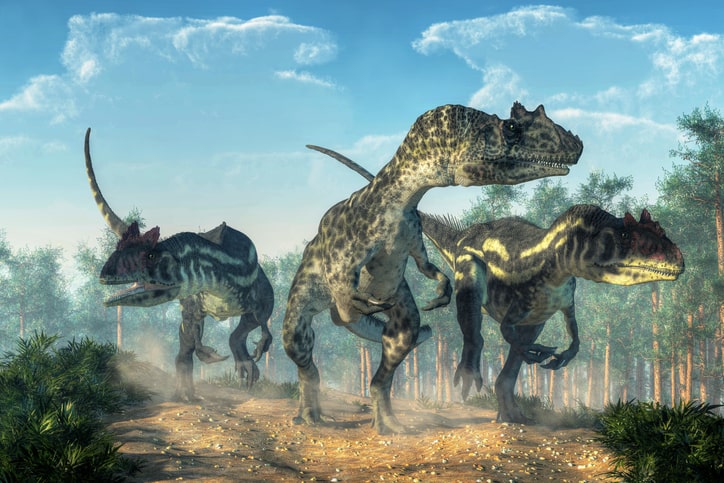
Scientific Name: Allosaurus fragillis
Period: Late Jurassic
First Discovered: Exact discovery unknown— first described in 1877
Allosaurus fragillis was anything but fragile. In fact, it rivals the Arocanthosaurus as the meanest state dinosaur or fossil.
Averaging over 8 meters long, packing a powerful bite, and able to run over 30mph— in its time it was perhaps the top predator in what’s now North America.
Allosaurus fossils are abundant in Utah, and many discoveries were made in the mid to late 1800s. It was first described by Othniel Charles Marsh in 1877 and its name means ‘different lizard’ due to differences in its vertebral structure that had never been seen before.
In 1960, work began in earnest at a site that had previously contained dinosaur fossils. The remains of over 70 specimens were found at what is now called the Cleveland-Lloyd dinosaur quarry in Emery County, Utah. It’s one of the densest concentrations of dinosaur fossils ever found and amazingly, 46 of the specimens were Allosaurus fragilli.
It’s not known how so many of these predators came to be found in one place, but one thing that was beyond doubt was the selection of Allosaurus when Utah assigned a state fossil in 1988.
Wyoming State Dinosaur: Triceratops
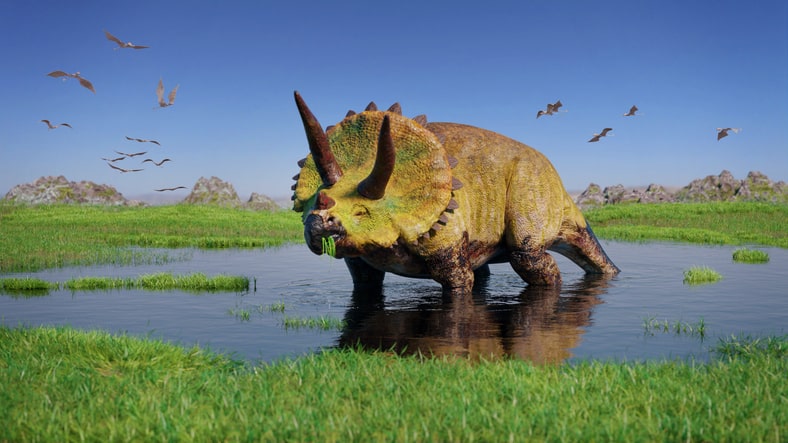
Scientific Name: Triceratops horridus
Period: Late Cretaceous
First Discovered: 1887
The final dino on our list is arguably the most recognizable. The first specimen that was undoubtedly a Triceratops specimen was given to Othniel Charles Marsh in 1887. He originally thought they were bison horns, but soon realized that dinosaurs could have horns too.
Its name means ‘three horn face’, and it’s famous for its trio of prongs and its bony frill across the back of its skull. The function of the frill is subject to debate, much like the spine plates of the Stegosaurus.
Due to the robust nature of Triceratops’s skull (it’s one of the largest of any land animal), many well-preserved specimens have been found, several of them in Wyoming.
Following a state-wide vote by elementary school children, Triceratops became Wyoming’s state dinosaur in 1994.
It was already the state fossil of South Dakota, having earned that accolade in 1988.
Dig In Even Further
There you have it— all the state dinosaurs of America. Which one is your favorite? And with two new state dinosaurs in 2022, it may not be long before your state has its own state dinosaur too.
Why not finish with a dinosaur quiz (where you’ll find some of the answers in this article), or discover more of America’s state symbols?
